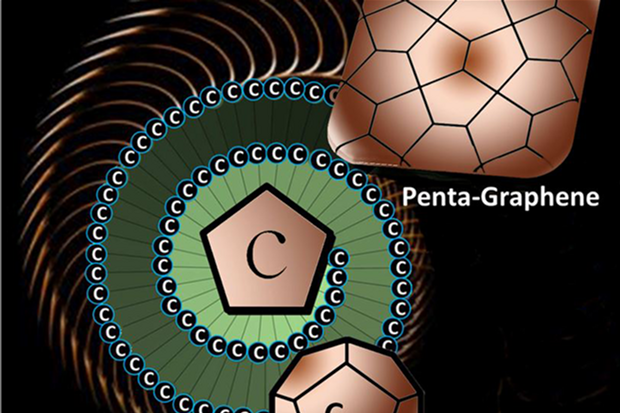
Penta-Graphene: a unique arrangement of carbon atoms inspired by the pentagonal tile patterned streets of Cairo is a structural variant of Graphene.
Image credit: Virginia Commonwealth University
Universities in Japan and China along with researchers from the Virginia Commonwealth University (VCU) have published a paper about the development of a variant of graphene - penta-graphene.
The material is a thin sheet of pure carbon atoms arranged in a pentagonal fashion with distinct structural properties.
The paper entitled "Penta-Graphene: A New Carbon Allotrope" is based on the research launched at VCU and Peking University, and will be published in the Proceedings of the National Academy of Sciences journal.
The three last important forms of carbon that have been discovered were fullerene, the nanotube and graphene. Each one of them has unique structure. Penta-graphene will belong in that category.
Puru Jena
Distinguished Professor - Department of Physics at VCU
The majority of forms of carbon are comprised of hexagonal building blocks and in some cases are dispersed with pentagons. Penta-graphene would serve as a unique two-dimensional carbon allotrope exclusively made of pentagons.
Qian Wang, Ph.D., a professor at Peking University and an adjunct professor at VCU, observed artwork on a wall while dining with her husband in a Beijing restaurant displaying images of the streets of Cairo.
I told my husband, "Come, see! This is a pattern composed only of pentagons. I took a picture and sent it to one of my students, and said, 'I think we can make this. It might be stable. But you must check it carefully.' He did, and it turned out that this structure is so beautiful yet also very simple.
Qian Wang
Professor - Peking University
Co-authors of the paper include; Kawazoe, Ph.D., from Tohoku University in Sendai, Japan, Xiaoshuang Chen, Ph.D., from the Chinese Academy of Science in Shanghai, Jian Zhou, Ph.D., a postdoctoral researcher at VCU and Shunhong Zhang, Ph.D candidate, from Peking University.
The researchers used computer modelling to simulate the synthesis of penta-graphene. The results suggested that the material would be stable at temperatures of up to 1000°K, and would possess very high strength and would even outperform its predecessor graphene in certain applications.
Penta-graphene has a number of interesting and unusual differences in properties compared to graphene such as it's a semiconductor, while graphene is an electrical conductor. The researchers also said that the material stretches in an unusual way.
You know the saying, diamonds are forever? That's because it takes a lot of energy to convert diamond back into graphite. This will be similar.
When you take graphene and roll it up, you make what is called a carbon nanotube which can be metallic or semiconducting. Penta-graphene, when you roll it up, will also make a nanotube, but it is always semiconducting.
Puru Jena
Distinguished Professor - Department of Physics at VCU
"If you stretch graphene, it will expand along the direction it is stretched, but contract along the perpendicular direction. However, if you stretch penta-graphene, it will expand in both directions," Wang said.
The mechanical strength of the material, derived from an unusual property known as Negative Poisson's Ratio, the researchers believe may hold especially interesting applications for a variety of technologies including nanotechnology, biomedicine, electronics, etc. Synthesising the material is the next step for the researchers.
"Once you make it, it [will be] very stable. So the question becomes, how do you make it? In this paper, we have some ideas. Right now, the project is theoretical. It's based on computer modeling, but we believe in this prediction quite strongly. And once you make it, it will open up an entirely new branch of carbon science. Two-dimensional carbon made completely of pentagons has never been known," Jena said.